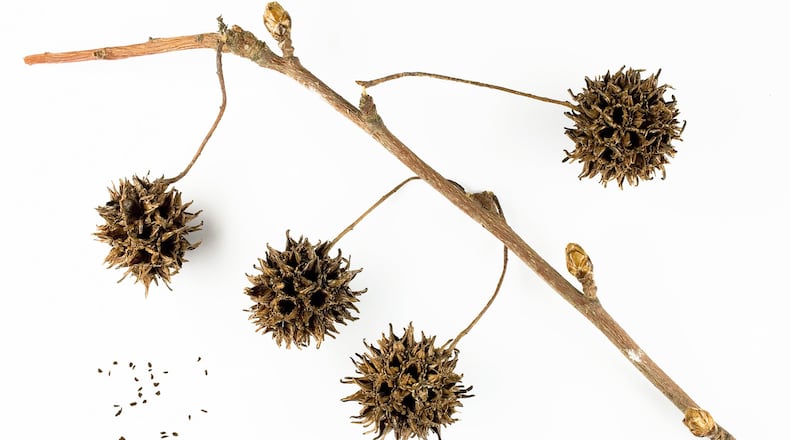The American sweetgum is one of Georgia’s most common trees, occurring in forests, yards, parks and neighborhoods across the state. Its distinctive round, spiked, dark-brown seedheads, commonly known as “sweetgum balls,” also make it one of Georgia’s most recognizable trees — and perhaps one of its most maligned.
The golf ball-size sweetgum balls are the tree’s fruits. They begin as pale green, spikey balls in spring and ripen into brown, seed-laden fruits by late summer. In the fall, little holes appear in the ripe fruits to release the seeds. An array of birds and other wildlife, though, will open up the fruits on their own to feast on the seeds — a valuable food source for the creatures in fall and winter.
I particularly enjoy watching Carolina chickadees this time of year, probing the gumballs with their bills and using amazing acrobatic skills to get to the seeds.
Deprived of their seeds, dried-out sweetgum balls will drop steadily from tree limbs through the winter. Woodland hiking trails — and yards and neighborhoods that harbor sweetgums — may become literally carpeted with the seedheads.
Mostly because of its value to wildlife, the sweetgum, so-called because of the gummy substance exuded from its bark, is one of my favorite trees. The tree also serves as host plant for more than 30 species of moths and butterflies. Ruby-throated hummingbirds sip nectar from it during the spring.
I also love the sweetgum’s stateliness (80 to 100 feet tall), star-shaped leaves, beautiful fall colors and summertime shadiness.
However, not everyone feels the same way. Some even hate the tree. Its heavy fruit production can cause headaches for homeowners who must rake up the balls. The gumballs can be unpleasant to walk on; if wet, they can be slippery and hazardous.
To me, though, the sweetgum’s value for wildlife far outweighs its disadvantages.
In the sky: From David Dundee, Tellus Science Center astronomer: The Geminid meteor shower, visible all next week, will peak at 50 meteors per hour Wednesday night. Look to the east from about midnight until dawn.
The moon will be full Tuesday. Mercury and Venus are low in the west and Mars low in the southwest around nightfall. Jupiter rises in the east around midnight.
About the Author
Keep Reading
The Latest
Featured


